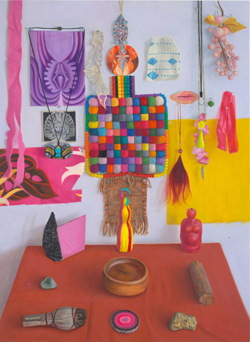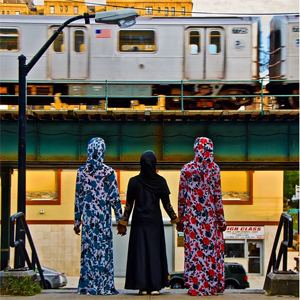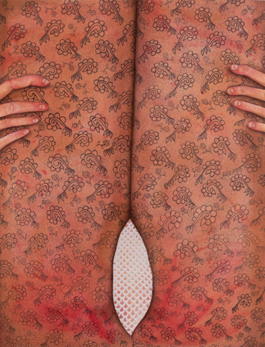An Altar to Obsession
John Haberin New York City
Clarity Haynes, Ruben Natal-San Miguel, and Katarina Riesing
An altar is a sacred place, and an artist who makes altars implicitly demands reverence. Yet she is also sharing her values and obsessions—what she, too, regards with respect, wisely or not. If she can do so with a bit of irony or trickery, all the better.
So it is with "Altar-ed Bodies" by Clarity Haynes. Her paintings take both their realism and fantastic elements seriously. They are frank to the point of humility, but also intimidating, like photographs by Ruben Natal-San Miguel. His very artistry puts the viewer on the spot, most especially the white male viewer, along with the very notion of beauty. Must art, then, make you squirm in order to assert a gendered identity? Does it still have that power, now that feminist art routinely incorporates such creature comforts as fabric patterns and decoration? Maybe only if the artist must squirm a little, too, like Katarina Riesing. 
Gender as intimidation
One might wonder right off if art can intimidate anyone these days. Modernism's "shock of the new" was already all but past, even as a popular critic celebrated it on TV. Robert Mapplethorpe, once a public scandal for arts funding , has become probably the most frequently exhibited photographer in art—almost matched only by a dedication to the urban underworld of New York in Diane Arbus. Still, Mapplethorpe packs a punch even now because he put himself on the line even as he neared death from AIDS. That same vulnerability can keep the confluence of painting and gender fresh as well. Clarity Haynes gets under your skin because you can feel her skin creeping, too.
Haynes presents two distinct bodies of work, the altars and the bodies. The first are still lifes, of what might be a corner of her studio or her imagination. The second are nude portraits or self-portraits, but only from the waist to the neck. The turn to still life is a recent addition. She also paints on two scales, one roughly life size and the other like miniatures. The first throw one back and the second draw one close, and it is hard to say which is more discomforting.
She paints with, well, clarity but just short of photorealism. She brings out the texture of earthenware and raw flesh, and there is plenty of both. Still lifes often show a table up against a wall and the wall itself, with a display of small objects from decorative fabric and feathers to totems and smooth stones. The wall also holds images of older women's art, private parts, or both at once—as in the work of Georgia O'Keeffe, including O'Keeffe drawings. They might be collected prints and postcards, or just quotes, but then lips break through one wall from another world entirely. They have equal claim to reality.
The women's bodies have sagging breasts and huge bellies, veering every so often from flesh tones to unlikely colors. But then Haynes has generally lightened her palette, so that even earth tones look bright. The altars really have altered the bodies and, no doubt, vice versa. The bodies also sport necklaces like oversized charm bracelets, with further tokens of the artist's charmed private world. They have an abundance of tattoos as well, suggestive of love, sex, violence, or affirmation. Like the still lifes, the obese and headless bodies are humble subjects from which there is no looking away.
One has entered Catherine Opie territory, but in paint rather than photographs, and the territory of LGBTQ art and gender bending. I had not realized that making altars has a history in women's art and the self-titled Feminist Art Movement that Mira Schor helped bring into existence. There, too, it was rescuing decorative art and household objects as matters of pride. Altars for Haynes could be real or metaphoric, and paintings are necessarily both. One can see her two bodies of work as complementary or as metaphors for one another. Her body is her temple.
The discomfort for me excludes reverence, and I have to wonder who is worshipping at her temple, but that could be a good thing. She might well insist on it, ;as part of the dialogue between arrogance and humility, the real and the imagined, the frank and the private. The tables almost share the picture plane with the walls. To the extent that they also share a single-point perspective, it places the viewer right up against the paintings, just as the naked bodies are way too close for comfort. Then again, Haynes might just paint what she is seeing at a given moment. Either way, she is putting you in your place—and in hers, too.
A terrible beauty
The photographs in "Women R Beautiful" include little girls dressed for Easter, twins in their Sunday smiles and Sunday best. They include a teen boxing champ, looking young for her age, and an elderly woman on what was to be her last birthday. They show a woman looking down, a cigarette in her mouth and a white bow in her hair after Billy Holiday, looking like she may not see many more herself.  They show women in curlers and an African American in a blond wig. They show Muslims in burqas and a woman at the beach in a towel ("old school style," a title explains). They show enough hair dye to repaint the Sistine Chapel.
They show women in curlers and an African American in a blond wig. They show Muslims in burqas and a woman at the beach in a towel ("old school style," a title explains). They show enough hair dye to repaint the Sistine Chapel.
The woman wear, by any conventional standard, too little make-up or way too much, but they disguise nothing. They have outrageous taste in jewelry, and they know it, like earrings in the shape of handcuffs or dollar signs. They may pose as a sex goddess out of a forgotten movie, a "voodoo princess," or just a Puerto Rican mother holding her little girl. They may share the occasion with clothes driers, a boom box, or a halal hot dog—with a great view of the Brooklyn Bridge or with one foot up on a fire plug. They may protest that Black Lives Matter, holding picket signs, or that they themselves, in the words on a necklace, are self-made. And that makes sense, for this is about not just the proclamation of beauty, but also its construction, by women or by those who ask to admire them.
Plainly Ruben Natal-San Miguel has a terrible idea of women or beauty, or else a terrible beauty is born. Of course, I mean the latter, and he is out to correct the past. His series title may sound like a platitude out of fashion magazines or an excuse for the male gaze, but he way too self-aware for either one. He riffs on "Women Are Beautiful," a theme to which Garry Winogrand returned for years, mostly in the 1960s. Natal-San Miguel sees the earlier series as racist and sexist, if only in its innocence, and he demands a whole new standard of beauty. Make that standards—for women of all races and, for that matter, genders who will not be pigeon-holed.
The women may seem united in their defiance, but he is not just sending a message. This is not the high-toned African American street life of Mickalene Thomas, Amy Sherald, Titus Kaphar, or Kehinde Wiley. Those twin girls are ever so sweet, and the Muslims, backs to the camera, will never face you down. The elderly woman at the show's center, past a first room for Serkan Ozkaya, is the artist's mother. He considers her photo, somewhat smaller than the rest, an affectionate snapshot, and the affection is palpable. The sole photograph without a person, a marquee for Closing Time, could apply poignantly to her as well.
Mere snapshots do not come naturally to Natal-San Miguel, and these women are also united in his artistry—the art of construction. The letter V in yellow on a red brick wall picks up the dip between the twin girls. The Muslim girl in black stands between her taller companions in colorful patterns, hand in hand. All three face an elevated train, its steady horizontal marking their rise and fall. The clothes driers come in decorative colors, too, and a florist blends into her flowers. Come to think of it, the mother's birthday cake and table lamp merge visually, for a heightened celebration.
He prints on aluminum, for the painterly touch of an old film poster. He uses other past references, too, for his contemporary beauty. Woman cops and landlords pose on Harlem stoops, like jazz musicians for Art Kane or Gordon Parks, and a Chinese American poses as Girl with a Pearl Earring by Jan Vermeer, without the pearl. Not that Winogrand himself was complicit with convention. He captures women in casual conversation and in the plain clothing of their time, as on a bench at the 1964 World's Fair. Yet Natal-San Miguel will never settle for women in the act, because his women are always putting on an act—an act thoroughly and memorably their own.
Feel the burn
The very thought of a razor burn makes me uncomfortable, and so does "Razor Burn" by Katarina Riesing. Artists like Haynes have used their own raw flesh and fetishes to make viewers squirm, especially straight male viewers. Many more have used textiles and decorative patterns to reclaim "women's work" for women, as a matter of pride. Riesing does both, much like Brenda Goodman, in close-ups of a woman's body barely covered if at all. You can feel the burn. She differs from most, though, in that she is squirming that much more.
Works on silk confront the viewer with a single upper body, much as with Haynes—its head cut off and out of the picture. Flesh may remain visible through sheer fabric, right down to ghastly spots that could well be razor burns, if not something more infectious or an allergic reaction to art. Thicker fabric appears to cover the picture plane in other works, as if stifling the body, while stripes discolor one figure that much further. One can hardly overlook that, traditionally, an obsession with appearance, whether in clothing or in "purifying" the flesh of unwanted hair with a razor, reflects the warring demands of female self-assertion and enforced standards of beauty. In one image, hands to each side draw apart the fabric. One can hardly overlook, too, their firmness and self-control. 
They also just happen to leave a pronounced gap in the patterning, in a shape that recurs often for Riesing—the oval of a vagina. Then, too, the silken translucency is real, if only one can decide what to call the ground and what an illusion. She also incorporates gold threads, embroidered by hand. Works on paper have a still greater precision, in colored pencil and ink. There bare limbs cluster to the point of anonymity, as in a meat locker or a collective dance. They resemble dolls in a Surrealist photograph by Hans Bellmer.
Still, the decorative realism is pleasant enough, even reassuring, for anyone but her. Those hands may hold firm, but Riesing does not seem at all proud of that upper body. It squirms quite enough by itself. The silk lends its patterns to flesh, as if rubbing in the burns. In another image, traces of gray could belong to the wood grain of a panel, but again silk serves as ground, with dye in place of paint. Puns like these turn the discomfort around, as if it arose from painting itself.
In another drawing, blackness has the last word, twice. The black of bra straps does not look in the least seductive, no more than the bony, irregular body beneath. (Bumps of what I take, hesitantly, to be a spinal column have the overall shape of another vagina.) Nestled beneath the bra, as if constrained by its pull, the outline of another woman shows her back, too—while drawing up her legs and burrowing into her chest, for whatever comfort she can take. It could almost be a tattoo, willfully inflicted as an assertion of identity or a token of love, but it never quite fits into the larger body with her delicate shading. It leaves one admiring Riesing's honesty and skill, while feeling the pleasure and the pain.
Katherine Hubbard, too, has to look out for herself. She finds another space between painting and photography, as "Avoid Glancing Blows." Her photograms have a painterly touch, but their dark blur is also a form of disguise. Images include legs underwater, not so very far from Riesing's body parts. Others depict run-down interiors and murky landscapes, like a lament for fly-over country, while tall prints of hanging tapestries recreate them on paper while leaving them in ruins. The dappled light, like Riesing's pencil and silk, more than makes up for the damage—and the threat.

Clarity Haynes ran at Denny Dimin through January 25, 2020, with an assist from Invisible-Exports, Ruben Natal-San Miguel at Postmasters through July 11, Katarina Riesing at Asya Geisberg through February 15, and Katherine Hubbard. at Company through February 23.




